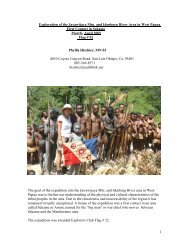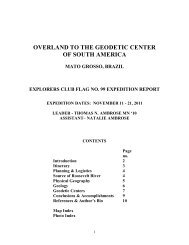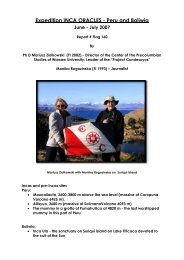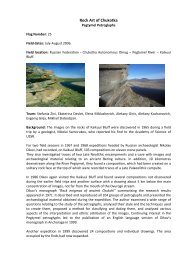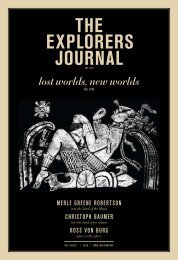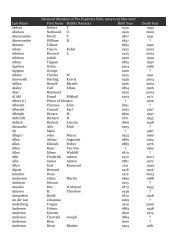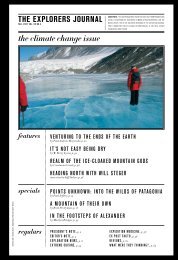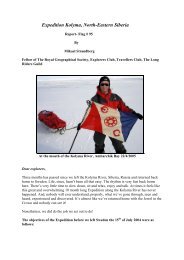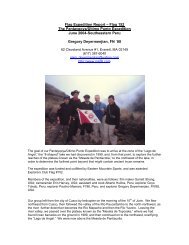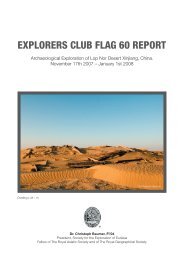the explorers journal - The Explorers Club
the explorers journal - The Explorers Club
the explorers journal - The Explorers Club
You also want an ePaper? Increase the reach of your titles
YUMPU automatically turns print PDFs into web optimized ePapers that Google loves.
<strong>The</strong> <strong>Explorers</strong> Journal recently caught up with STS-<br />
125 astronaut Mike Massimino, 47 and a native<br />
New Yorker, to talk about his mission’s record-setting<br />
extra vehicular activity (EVA)—at 36 hours and<br />
56 minutes, <strong>the</strong> longest, and perhaps most complex<br />
in NASA history—and what <strong>the</strong> future holds<br />
for one of astronomy’s most precious assets. This<br />
recent foray into space was Massimino’s second<br />
Hubble servicing mission. During his first, aboard<br />
STS-109 in March 2002, he and his colleagues<br />
upgraded <strong>the</strong> instrument’s power supply; installed<br />
a new camera, new solar arrays, and a new cooling<br />
system; and replaced a series of gyro stabilizers.<br />
EJ: From what we hear, <strong>the</strong> mission set a new<br />
record for endurance.<br />
MM: We did. Four of us—John M. Grunsfeld, Michael<br />
T. Good, Andrew J. Feustel, and myself—carried out<br />
<strong>the</strong> repair during five spacewalks over a five-day<br />
period. We set a record of 35 hours 55 minutes on<br />
STS-109. On this mission, my two walks totaled 15<br />
hours, 58 minutes. I guess you could say it was a<br />
couple of long days at <strong>the</strong> office.<br />
EJ: We assume you were under a bit of pressure<br />
to “get it right”<br />
MM: We had practiced <strong>the</strong> maneuvers over and<br />
over again in <strong>the</strong> pool over <strong>the</strong> course of two and<br />
a half years. Every time we missed something or a<br />
task took longer than initially estimated, we would<br />
go back and refine <strong>the</strong> maneuver or <strong>the</strong> tool kit used<br />
to carry it out. I constantly kept a mental checklist<br />
of all of <strong>the</strong> things that could go wrong. <strong>The</strong> idea<br />
was to minimize <strong>the</strong> number of things that could go<br />
wrong. And <strong>the</strong>n, of course, <strong>the</strong>re is <strong>the</strong> worry that<br />
you accidentally break something. Can you imagine<br />
coming back and having to tell your family, your colleagues,<br />
<strong>the</strong> whole world, “Yeah, that’s me, I’m <strong>the</strong><br />
guy who broke <strong>the</strong> Hubble,” or having astronomy<br />
books that said, “We would know <strong>the</strong> answer to<br />
this important such-and-such a question if it weren’t<br />
for Mike screwing up <strong>the</strong> Hubble…” I guess you<br />
could say it adds an element of pressure.<br />
EJ: How hard was it to carry out <strong>the</strong> work<br />
MM: It is probably far more tedious than difficult.<br />
One access panel had 117 small fasteners that had<br />
to be removed—and <strong>the</strong>n put back. When you have<br />
so much to do, you have to focus on just one task at<br />
a time, removing one bolt, disconnecting one wire.<br />
You cannot get ahead of yourself or allow yourself<br />
to get distracted. If you do, it will bite you.<br />
EJ: After all of that practice, did you encounter any<br />
surprises once <strong>the</strong> actual repair was underway<br />
MM: At <strong>the</strong> beginning of <strong>the</strong> first spacewalk, one of<br />
<strong>the</strong> handle bolts on <strong>the</strong> wide-field camera, which<br />
we were replacing, just wouldn’t give. Ultimately,<br />
we decided to just break <strong>the</strong> handle off. I have told<br />
Jeff [Hoffman] it was “all his fault” since he put<br />
<strong>the</strong> camera handle bolts in so tightly during <strong>the</strong><br />
first Hubble servicing mission in 1993. Actually,<br />
he just did his job. I just had to undo his overly<br />
efficient job. On <strong>the</strong> second spacewalk, one of<br />
<strong>the</strong> replacement gyros wouldn’t fit inside <strong>the</strong> telescope.<br />
Luckily we had ano<strong>the</strong>r one that did fit.<br />
EJ: What all did <strong>the</strong> STS-125 mission accomplish<br />
MM: We put in two new scientific instruments:<br />
a cosmic origins spectrograph, which collects<br />
ultraviolet photons, and a new wide-field camera,<br />
which will allow us to see even deeper into <strong>the</strong><br />
universe. We repaired two failed instruments: <strong>the</strong><br />
space telescope imaging spectrograph and <strong>the</strong><br />
advanced camera for surveys. We also put in new<br />
batteries, new gyroscopic stabilizers, a new computer,<br />
a refurbished guidance sensor, and replaced<br />
<strong>the</strong> insulation around several instruments. We also<br />
installed a device to aid in de-orbiting, when <strong>the</strong><br />
telescope is eventually decommissioned.<br />
EJ: So after all of your hard work, what is <strong>the</strong> future<br />
of Hubble<br />
MM: I think we will get ano<strong>the</strong>r ten years out of<br />
Hubble, because of <strong>the</strong> repairs and because of what<br />
we have learned about rationing its power and rotating<br />
<strong>the</strong> use of its gyros so <strong>the</strong>y will last longer. <strong>The</strong>re<br />
are six [gyros] on Hubble but it can be manipulated<br />
using only two. Hubble has been a great project to<br />
be associated with as <strong>the</strong> information it is providing<br />
is for everyone, not just for a privileged few.<br />
EJ: Tell us about <strong>the</strong> IMAX film.<br />
MM: When I did my first spacewalk eight years ago,<br />
I came back thinking, “It just doesn’t get any more<br />
beautiful than that.” Because <strong>the</strong> shuttle orbits <strong>the</strong><br />
Earth every 90 minutes, <strong>the</strong> transition from day to<br />
night is really dramatic. <strong>The</strong> view of <strong>the</strong> Earth is fantastic.<br />
It is as close as one can get to seeing heaven,<br />
only better. With this most recent mission, I feel <strong>the</strong><br />
same. I just wanted <strong>the</strong> whole world to see what I<br />
had <strong>the</strong> privilege of seeing. Now <strong>the</strong>y can.<br />
<strong>the</strong> <strong>explorers</strong> <strong>journal</strong>



